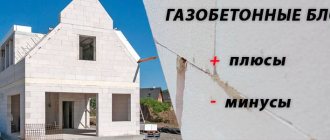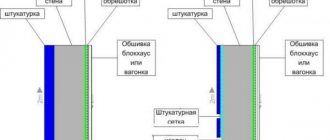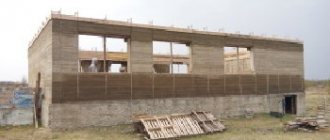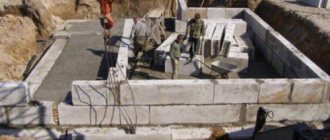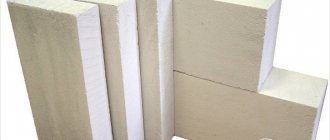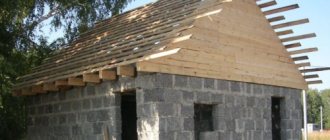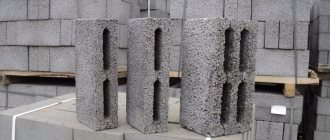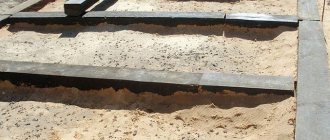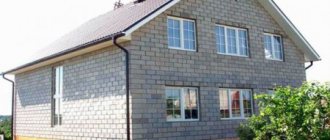A true fan of a bathhouse with a birch broom - I have been nurturing my dream for several years. And there were always many reasons to postpone the implementation of the idea.
First, I selected a location: in the fall, I moved the greenhouse and cut down the old apple tree. It turned out that the next year was a leap year, and the relatives unanimously persuaded not to build anything.
The following winter I devoted to studying articles on the Internet, calculating options for laying the foundation, erecting walls and roofing, as the most expensive items in the budget.
At the same time I saved some money. I planned to spend 150 thousand rubles.
This story was sent by my subscriber Gennady.
Features of the Russian steam room
The human body temperature in any environment is no more than 400. This is achieved by the fact that when the ambient temperature rises, a person sweats and releases excess heat with moisture into the surrounding air. Optimal parameters for health - a combination of temperature and humidity - can only be maintained in a Russian bath, and only if it is properly designed and built. “The bathhouse is the second mother,” is written on the base of a wooden sculpture by an unknown artist.
Sculpture “Bathhouse - the second mother”
A bathhouse is not the cheapest pleasure, and if you order it “turnkey”, the amount may turn out to be prohibitive. Therefore, we are going to build a bathhouse with our own hands. This is quite an affordable business if you have some of the skills of a strong housewife: be able to lay bricks and work with wood, be able to read a drawing and calculate the necessary materials.
Bath structure and material
The bathhouse consists of a steam room itself, a washing room - where there is a font, a tub for dousing or a shower, and a dressing room. It takes its roots from the traditional Russian steam bath. This device has been known for many centuries and has changed little. The sauna house is now placed on a solid foundation, is properly insulated, has a high-quality stove with a chimney, and drains into a septic tank.
Waiting room
They undress in it, store towels, washcloths and brooms, relax between visits to the steam room, and serve as a barrier to cold air. There is a window there - for safety reasons and for beauty.
Waiting room for a block bath, lined with clapboard
Steam room
It contains a heater with a water container, and built a bed or shelves for lying on. The oven provides uniform, strong heating and exposure to superheated steam without convective air mixing.
Steam bath made of blocks, lined with clapboard
Washing
There is heat from the back wall of the stove, and we cool down in the font or under the shower, continuing to remove waste and toxins from the body.
Sink in a bathhouse made of blocks, lined with decorative stone and tiles
What materials are used
Now we have to choose the material for our future bathhouse, keeping in mind the simplicity and cost of construction. Nowadays you can build a bathhouse from anything.
Frame construction
Of course, you can build the cheapest sandwich sauna from a frame, insulation and other semi-finished products. But such a bathhouse, although quite beautiful in appearance, will turn out to be very short-lived, since it is impossible to completely insulate it: condensation will accumulate inside, which will lead to rapid rotting of the structure.
Steam room of a frame bath, the stages of insulation and waterproofing are visible
Wood: timber and logs
The most traditional material is wood. We have two options: to install a bathhouse from timber or logs. It is beautiful, practical, warm, but not very durable, expensive and difficult to build yourself.
Types of baths made of simple timber and rounded logs
Brick
Brick will provide almost no cost savings. It is strong, durable, heat- and fire-resistant, beautiful, and has good thermal insulation, especially in the hollow version. But the higher quality the brick, the more expensive the bathhouse will be. Construction will also increase the cost of a more massive foundation, which a brick building requires.
Bathhouse made of red brick, roof - metal tiles
Blocks
Concrete blocks are foamed concrete of various compositions. They appeared in order to improve the thermal insulation qualities of walls and facilitate their construction. Special foaming agents were found. When forming a block in concrete by adding them, a chemical reaction takes place - gas bubbles are created. The finished block is much lighter than a solid block of the same composition. Therefore, they can be made quite large, which greatly speeds up the construction process.
Different blocks with different filling
The degree of thermal insulation, the weight and size of the block and the design of the required foundation depend on the type of block.
Examples of blocks with different fillings
- Pros. Due to their air content, they have excellent thermal insulation properties; frost-resistant; fire resistant; easy to process; immensely durable; not subject to shrinkage during construction; do not need a special foundation: it can be built from the same blocks.
- Minuses. They are afraid of moisture: water frozen in the pores can completely destroy the block; therefore, they require external waterproofing sheathing and good internal water and thermal insulation. And they are fragile and do not withstand compression well, but in our low design this is unimportant.
How to do it well
You need to carefully select the material for construction, paying attention to the following points:
- Manufacturer. Well-known companies care about their reputation. They have all the necessary certificates confirming the high performance properties of their products. Research aimed at quality control is regularly carried out;
- Price. If the price is lower than that of competitors, then this fact should raise suspicions about the quality of the building material. Typically, a discount is provided due to either proximity of production, or bulk order quantity, or low grade of material;
- Warehouse conditions. The blocks should be stored in a dry place where moisture cannot penetrate;
- Package. Must not be damaged.
Information. The unsuitability of building materials can also be detected through a simple inspection. The way they look can tell a lot about their quality.
When inspecting the blocks, you can glean the necessary information from the following signs.
- On the inner surface. It can be studied by breaking the block into parts. The building material from the inside must be the same as the outside. The pores should not be connected, otherwise the blocks will absorb moisture;
- Pore size. The larger they are, the lower the strength of the building material;
- Color. Since cement is the predominant component of the blocks, their surface should be painted a monotonous gray shade. Too light building material was produced in violation of standards, since it does not contain enough cement;
- Form. If, when you put two blocks together, gaps are found between them, then when building a bathhouse you will need too much mixture or glue;
- Weight. This indicator should also remain within normal limits.
To test a block for strength, you need to try to break off part of its edge by pressing with your hand. If a piece falls off, this indicates poor quality of the material.
Information. Another way to test the block is to pierce it by hand with a large nail. If the nail enters without strong pressure, then it is not recommended to use this building material for a bathhouse.
Preparation for construction
Based on all the indicators and our purchasing power, we chose aerated concrete blocks for the bathhouse, which have a thermal conductivity coefficient even lower than linden, with dimensions of 600x200x300 mm.
Size and design selection
We decided to build a small, inexpensive bathhouse for one family of three or four people. The height of the bath is usually determined by your capabilities, but traditionally the height from floor to ceiling should be 220 or 230 centimeters. Let's take the dimensions of the bathhouse as 5.5x5 meters. Let's draw an approximate drawing. You can visualize it on your computer.
Three-dimensional drawing of a future bathhouse in 3DMax
Selecting a location
If the area is small, then you don’t have much choice. But if it is big, then there is a chance to use all its advantages. A simple and cheap foundation can be limited to good solid soil and deep groundwater. Their close occurrence can be recognized even visually: where the midge curls in a column on the site, it is damp. According to SNiPs, a bathhouse should not be located close to a well (a bathhouse is considered a source of pollution), a house (to avoid fire), a toilet and a compost pit (to avoid washing away their contents). The nearest tree from the bathhouse should be at least 15 meters.
Drawing of choosing a location for a bathhouse, taking into account all the buildings and trees on the site and the neighbor’s fence
Coordination of the design of the future bathhouse with administrative authorities
Without approval of the project before the start of construction, an already built bathhouse can be demolished due to any complaints from neighbors, and you will lose the labor and money invested. The project should include the following items:
- A plan (floor plan, even if you have one floor), created according to all drawing rules with specifications, sections and explication.
- Approximate estimate for materials.
- Planned type of foundation with drawing.
- Consent of the closest neighbors for construction.
An example of a bathhouse design sheet for approval
Calculation of the number of blocks for construction
It is difficult to accurately calculate the amount of material for a block bath with such rough guidance as we can give in one single article. We can only give an approximate picture. You can find calculators online to calculate the number of blocks. We'll use any. Doors and windows will be taken as the arithmetic average size. We will lay the walls in half a block with glue. Taking into account the accepted project, dimensions, weight and density of the blocks, we fill out the table.
Table for calculating the number of blocks and glue
We get the result.
Calculation result
Construction of a building
Anyone who knows the basics of using hand and power tools and has a general understanding of construction can build a bathhouse from cinder blocks on their own.
Making masonry mortar
Mixing the mortar for laying cinder blocks:
- In one container mix 3 parts sand, 1 part cement. Mix the ingredients thoroughly.
- Slowly adding water, stir the solution until the required consistency is obtained.
To increase the plasticity of the finished solution, you need to add special plasticizers to it, which are sold in construction stores.
Foundation and floor
The construction of a massive building begins with the construction of a foundation:
- Make markings on the site, indicate the location of the building.
- Cut off the soil layer to a depth of 10 cm. Remove it outside the future building.
- Further work depends on the chosen type of foundation.
Pile foundation:
- Mark the locations of the holes. The distance between them is 1.5 meters.
- Dig holes to a depth of 90–110 cm. Place a 30 cm thick layer of sand and crushed stone on their bottom.
- Make formwork that should be 50 degrees above ground level. It is easier to make it from stainless steel sheets.
- Place reinforcement bars inside the formwork for reinforcement.
- Mix cement mortar with fine crushed stone and pour to the top of the formwork.
To strengthen the pile foundation, it is necessary to make a concrete grillage connecting all the posts.
Strip foundation:
- Mark the location of the trenches. Dig them to a depth of 40 cm.
- Put together the formwork panels and secure them along all the trenches on both sides. The height of the formwork is 40 cm.
- Tie together reinforcing frames from reinforcement and place them inside the formwork.
- Fill the trenches with cement mortar.
Wait until the foundation hardens.
Walls
The process of laying monolithic blocks:
- Before laying cinder blocks, cover the foundation with a layer of waterproofing. You can use roofing material for this.
- Lay out the corners. To do this, you need to connect two stones of the first row and cover them with blocks of the second row. Check the evenness of the corners with a building level.
- Place the first row. When it is finished, repeat laying the corners for another row, check their level, and move the thread higher.
This is how the walls are built to the very top. The mortar that protrudes between the individual bricks must be removed with a trowel.
Windows and doors
When laying walls, you need to pay attention to doors and windows. In their place you need to leave free space
In this case, individual cinder blocks are cut to the required sizes to leave space for a window or door.
The top of the window or door is arranged differently. You need to place two long metal corners on the side walls, inside of which there will be a closing row of bricks on top of the window or doorway.
Ceilings and roof
Features of the construction of ceilings and roofs:
- Ceilings can be wooden or with concrete floors. The second option is relevant if the bathhouse has a second floor. If there is none, you can make a wooden ceiling. To do this, you need to secure the beams - the distance between them should be 60 cm. Stuff the rough ceiling.
- To build a roof, it is necessary to prepare wooden rafters, which are installed at the required angle at the ends of the beams. After this, the sheathing is placed on top of the rafters.
Next, all that remains is to make a vapor barrier, select a roofing material, and secure it to the rafters.
Communications
Communications in the bathhouse must be carried out at the stages of construction of walls and floors. If this is not done in advance, problems may arise later.
It is important to think about the location of the drain and assemble it from plastic pipes. Cinder block walls can be drilled with a hammer drill if it is necessary to pass wires or a gas pipe through them
Finishing
Finishing is necessary both externally and internally.
Insulation from outside
If you do not do external finishing, the walls will simply be blown through. So you need to at least prime (with Ceresit ST-17 primer), and then plaster (ST-24) with a layer a little more than half a centimeter thick. You can continue finishing after installing doors and windows. Since aerated concrete is a fragile structure, the frames should be wide and attached to the concrete with anchor bolts as large an area as possible, and caulked with jute or tow. More complex external insulation consists of many elements that are attached on top of the sheathing made. The prepared facade can be covered with plastic siding or decorative plaster.
Insulation of aerated concrete from the outside
Insulation inside
Craftsmen advise covering the steam room and the bathhouse as a whole with foam glass tiles - simply placing them on glue. It is heat-resistant and has low thermal conductivity.
Foam glass is laid like tiles
Then the walls can simply be covered with clapboard.
Covering a block bathhouse with clapboard
A “warm floor” is laid on the floors, and tiles are placed on it.
Warm floor under tiles
Important! Before interior finishing work, you need to install all electrical cables and install taps for the water supply system and drains for the sewerage system.
After laying the tiles, ladders are installed.
Tile with ladder
Let's assume that we have overcome all the difficulties and our bathhouse is ready.
Pouring the foundation
- First you need to determine the strength of the soil at the site where the bathhouse will be built,
- Next you need to level the area for the bathhouse,
- Mark the territory and corners using pegs and ropes,
- Dig a trench about 0.6 m deep and about 0.7-1.2 m wide,
- Pour a layer of sand 0.1-0.2 m thick onto the bottom of the trench, compact it,
- Afterwards, you need to make wooden formwork over the trench, make a frame from reinforcement, and pour concrete into the formwork.
It takes 1 to 3 weeks for concrete to harden.
Construction of a bathhouse from aerated concrete blocks (video)
Of course, it is impossible to provide a detailed construction guide in one article. But the vector is given, and a meticulous person will find on the Internet and books everything he needs to build a bathhouse from aerated concrete blocks.
- Author: Maria Ya.
Good afternoon My name is Maria, I am a garment technologist by training, but I am well versed in many engineering fields and the world of design. I love writing popular articles on any topic and, it seems to me, I’m good at it. Working on the site gives me pleasure. Rate this article:
- 5
- 4
- 3
- 2
- 1
(49 votes, average: 4.1 out of 5)
Share with your friends!
